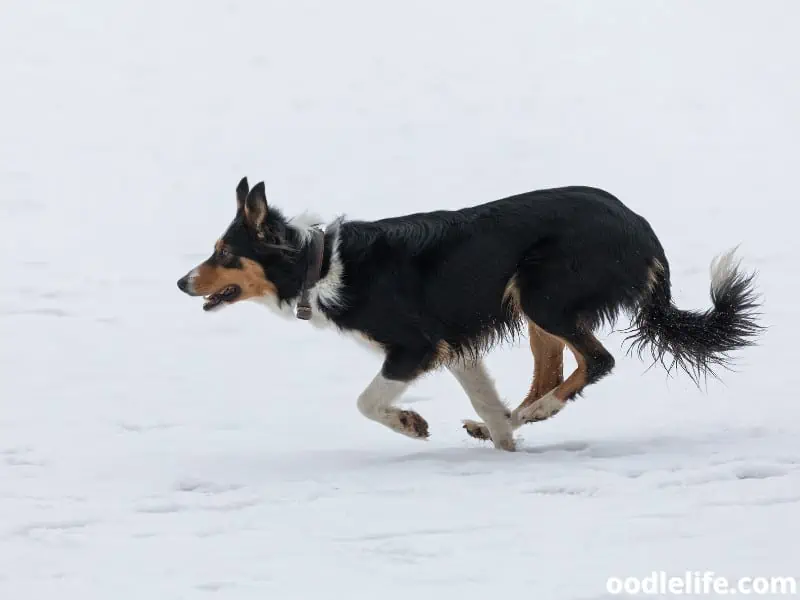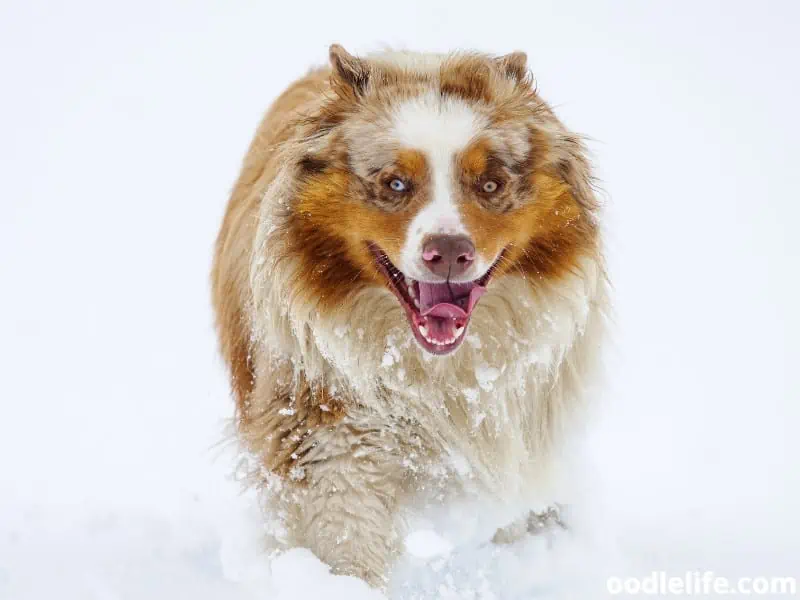7 Severe Warnings for Australian Shepherds in Cold Weather
Australian Shepherds are a popular breed known for their intelligence, versatility, and high energy levels. While they are accustomed to outdoor environments and can handle varying weather conditions, cold weather can pose some unique challenges. It’s essential for owners to understand how these dogs fare in cold temperatures and the potential health concerns that can arise, as well as methods for ensuring their comfort and safety during the winter months.
These adaptable dogs possess some natural cold-weather adaptations, such as their dense double coat, which provides insulation against the elements. However, like any breed, they can still suffer from weather-related health issues if not properly cared for.

To keep your Australian Shepherd happy and healthy throughout the cold season, it’s crucial to monitor their activity levels, provide them with a warm shelter, and take preventative measures against health risks.
Key Takeaways
- Australian Shepherds have a dense double coat that helps them tolerate cold weather, but owners should still be cautious.
- Weather-related health concerns can arise if proper care is not taken during the winter months.
- Providing warmth, monitoring activity levels, and addressing health risks will ensure your Australian Shepherd stays safe and comfortable in cold conditions.
Australian Shepherds and Cold Weather Adaptations
Double Coats
Australian Shepherds come equipped with a built-in cold weather adaptation – a double coat! This coat comprises a warm, soft, and insulating undercoat topped off by a water-repellent outer coat. You could call it “nature’s winter jacket” (but don’t tell the Aussies I said that, they might get a big head).

This double coat is key to keeping those energetic doggos cozy and snug even when the mercury drops low.
When it comes to shedding, Australian Shepherds shed their undercoat at least once a year, and more frequently in colder climates. So, it’s like they’re telling you: “Look, human, got a new, warmer coat, let’s run through the snow!”
Working Dogs in Cold Weather
Australian Shepherds were bred for their intelligence, agility, and, of course, their herding skills. I mean, let’s face it: they don’t get called “working dogs” for nothing! They’re used to working outdoors in various weather conditions, and their adaptability means they can handle the cold like pros.

Just like that friend who brags about wearing shorts in the dead of winter, these dogs have got it down.
In fact, the cold weather might bring out the best in Australian Shepherds when it comes to working. Most of them thrive in low temperatures because it allows them to use their energy more efficiently. So, whether they’re herding livestock, performing agility tasks, or simply running around in the backyard, they won’t let a little cold slow them down.
When your Australian Shepherd works in cold weather or enjoys a frosty jaunt, it’s essential to look out for signs of discomfort or distress. Check for ice ball formation between their toes, monitor their energy levels, and always provide a warm, dry shelter for them to rest in after a hard day’s work (or play).
In conclusion, Australian Shepherds are fantastic companions for colder climates, thanks to their fur coats and working dog lineage. They can make those frosty days more enjoyable, so get ready to embrace the cold with these four-legged fuzzy friends by your side!
Weather-Related Health Concerns
Australian Shepherds are known for their adaptability and hardiness in various weather conditions. However, exposure to cold weather can still pose some risks to their health. In this section, we will discuss the potential health concerns related to cold weather, including hypothermia, frostbite, and the impact of wind chill.

Hypothermia
Despite their fluffy coats, Australian Shepherds can still be at risk of hypothermia when exposed to extremely cold temperatures for extended periods. Hypothermia occurs when a dog’s body temperature drops below its normal range, affecting their ability to properly regulate body functions.
To detect if your Aussie is at risk of hypothermia, watch for symptoms such as shivering, lethargy, and decreased responsiveness. If you suspect hypothermia, provide a warm environment, and consider wrapping your dog in a blanket. Severe cases may require immediate veterinary attention.
Remember, it’s always better to be a helicopter dog parent and monitor your Aussie for signs of discomfort when out in the cold!
Frostbite
Frostbite is another cold weather-related concern for Australian Shepherds. Although their double coat provides insulation, their extremities, such as ears, tail, and paws, can be vulnerable to frostbite. Frostbite occurs when the skin and underlying tissues freeze, often due to prolonged exposure to cold temperatures and wind chill.
To prevent frostbite, limit your Aussie’s exposure to extreme cold and avoid long walks during harsh winter conditions. Keep an eye on those adorable paws and ears for any signs of discoloration, swelling, or discomfort.
Just like humans, dogs can benefit from bundling up too! Consider outfitting your Australian Shepherd with protective boots and a cozy coat for extra cold days.
Wind Chill Impact
Wind chill plays a significant role in how cold weather affects your Australian Shepherd. The combined effect of cold temperatures and wind can make it feel much colder than the actual temperature, increasing the risk of weather-related health concerns like hypothermia and frostbite.
To protect your Aussie from the impact of wind chill, consider investing in a windproof dog coat. Also, be mindful of the wind when choosing the best spot for their daily walks. No one likes to have the wind blowing in their fur when they can avoid it, right?
In summary, while Australian Shepherds are fairly resilient to cold weather, they can still experience weather-related health concerns like hypothermia, frostbite, and wind chill impact. Always be vigilant about monitoring your Aussie’s comfort during cold conditions and take preventative measures to keep your furry friend safe and healthy.
Protecting Your Australian Shepherd in Cold Weather
Paw Pads and Ice
Protecting your Australian Shepherd’s paw pads is essential during cold weather, as ice and snow can cause discomfort and even injury.

Here are a few tips to keep their paws safe:
- Keep pads moisturized: Apply a paw balm or a paw wax to keep their feet moisturized and prevent cracking. Be sure not to overdo it, as an excessive amount might leave their paws too slippery.
- Trim fur between pads: This will reduce the buildup of ice balls between their toes, which can cause pain as they walk.
- Foot protection: Consider investing in dog booties to protect their paws from ice and rough surfaces.
Remember, a good joke about dog shoes is paws-itively hilarious, but cold weather is no laughing matter for your pupper.
Keeping Warm with Moisture Management
Managing moisture is crucial for keeping your Australian Shepherd warm in cold weather.

Here’s what you can do:
- Dry them off: Make sure to thoroughly dry your fur baby after they play in the snow or get wet from melting ice. Make it a fun ritual by rewarding them with an extra treat after towel time.
- Proper grooming: Have a furry coat is helpful in the cold weather, but tangled and matted fur can trap moisture and exacerbate the chill. Regularly brush your Aussie to maintain a healthy coat.
- Dog jackets: For extra warmth, consider investing in a waterproof, insulated dog jacket to keep them cozy and dry during outdoor winter adventures. Trust us, they will thank you.
Just like a hot cocoa on a cold day, these tips will keep your Australian Shepherd toasty and happy in winter weather.
Special Considerations for Puppies
Australian Shepherd puppies, like all puppies, need some extra care during cold weather. Their little bodies aren’t quite as equipped to handle extreme temperatures, so it’s important to keep a close eye on them when the mercury drops. Let’s look at some ways you can keep your furball warm and safe during those chilly months.

First things first: keep an eye on the temperature and be aware of weather forecasts. For a puppy, anything below freezing can be a bit too cold for comfort. Consider dressing them in a puppy-sized coat for added insulation.
Stick to indoor activities if the weather outside is downright frightful.
Proper nutrition is vital for active and growing Australian Shepherd puppies. Make sure they’re eating a well-balanced diet full of nutrients to keep their energy levels up during cold weather. After all, a well-fed puppy is a happy and warmer puppy.
Now, despite their double-layer coats, Aussie Shepherd puppies can still feel the cold, especially on their little paws and nose. When you take them out for a walk or a bathroom break, check the ground for ice or snow. You could even have them wear protective booties to prevent cold, wet paws.
Indoors, make sure your puppy has a cozy space away from drafts and cold floors. Use a thick blanket or a heat-retaining dog bed to help them stay warm. Remember, puppies love to snuggle and feel protected, so don’t be surprised if they seek out a warm lap or nestle into a pile of blankets.
Lastly, monitor your pup’s behavior for any signs of discomfort. If your Australian Shepherd puppy shows hesitation when stepping outside or seems overly cold, don’t force them to stay out. Remember that their comfort and well-being should always be a top priority.
And there you have it – some handy tips to ensure your Australian Shepherd puppy stays warm, comfy, and ready to tackle the world, even in the cold weather. Bundle up and enjoy the winter wonderland together!
Frequently Asked Questions
How well do Australian Shepherds tolerate cold temperatures?
Australian Shepherds have a double coat that offers insulation against both hot and cold weather conditions. They can tolerate cold temperatures fairly well, but it is important to understand their limits and ensure their comfort and well-being.
What is the ideal temperature range for Australian Shepherds?
The ideal temperature range for Australian Shepherds is between 40°F and 85°F (4°C to 29°C). However, they can tolerate slightly colder temperatures as long as they have proper shelter and protection from harsh weather conditions.
Can Australian Shepherds live comfortably outdoors in cold climates?
If provided with adequate shelter and warmth, Australian Shepherds can live comfortably outdoors in cold climates. It’s important to make sure they have a dry, insulated shelter, access to unfrozen water, and proper nutrition to help them stay warm and maintain their energy levels.
Do Australian Shepherds require any special gear for colder weather?
While Australian Shepherds can tolerate cold weather, it’s advised to provide them with some additional gear for added warmth and protection. Some suggestions are to use a dog coat, consider using booties to protect their paws from frostbite and ice buildup, and have a warm, comfortable bed inside their shelter.
How do extreme cold temperatures affect Australian Shepherds?
Extremely cold temperatures can be harmful to Australian Shepherds, as they can suffer from hypothermia or frostbite if exposed for too long. If temperature drops close to or below freezing, it’s best to keep your Australian Shepherd indoors or offer extra precautions to keep them warm and safe.
Is it safe for Australian Shepherds to be outside during snowy or icy conditions?
Australian Shepherds can enjoy playing in the snow, but it’s important to be mindful of extreme temperatures, ice, and slippery surfaces. Ensure their paw pads are protected with booties, provide breaks for warmth, and monitor their behavior for any signs of discomfort or distress.